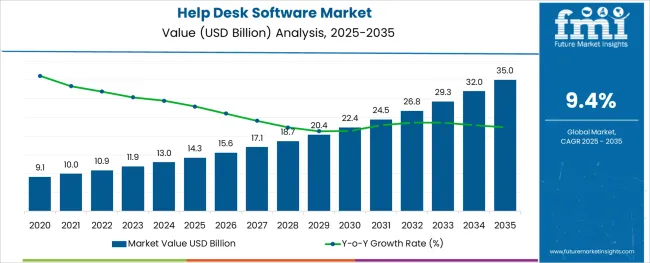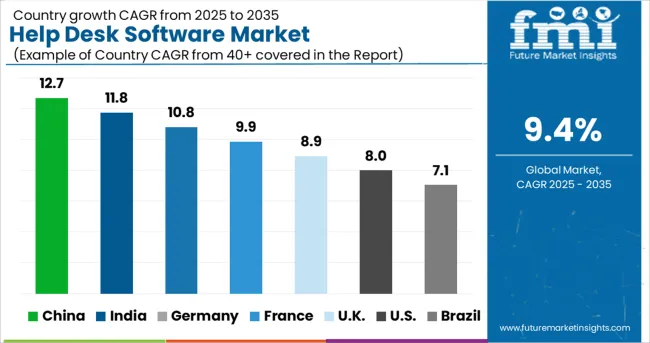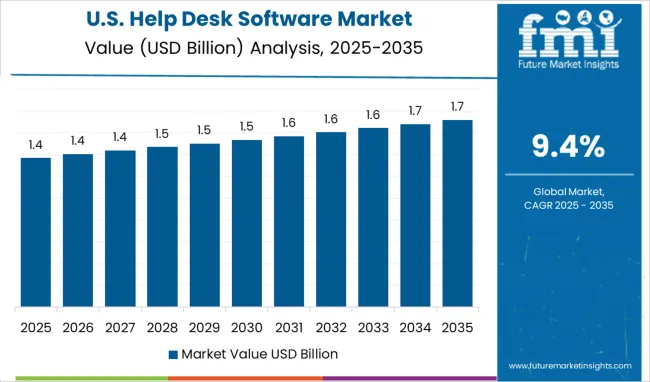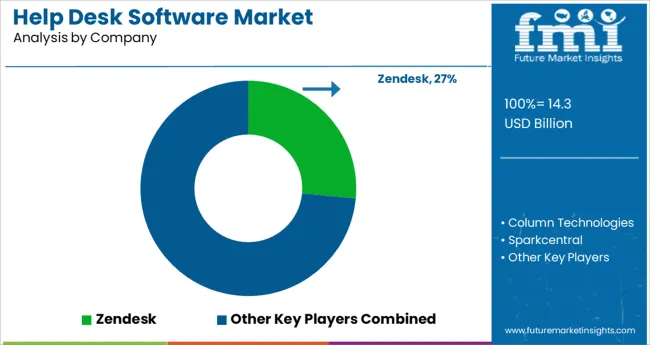The Help Desk Software Market is estimated to be valued at USD 14.3 billion in 2025 and is projected to reach USD 35.0 billion by 2035, registering a compound annual growth rate (CAGR) of 9.4% over the forecast period.

The help desk software market is expanding rapidly, driven by the increasing need for efficient customer support and IT service management across industries. Organizations are focusing on enhancing user experience and streamlining support workflows, which has led to widespread adoption of advanced software solutions. The growing trend toward digital transformation and remote working has accelerated demand for cloud-based platforms that offer scalability and accessibility.
Enterprises are investing in automation, AI-driven analytics, and omnichannel support features to improve response times and customer satisfaction. The market outlook is positive as businesses prioritize agile support infrastructure to handle complex service demands.
Segmental growth is expected to be led by the cloud-based software type and large enterprises as the primary application, reflecting the scalability needs and resource availability of bigger organizations.
The market is segmented by Type and Application and region. By Type, the market is divided into Cloud-Based and Web-based. In terms of Application, the market is classified into Large Enterprises and Small and Medium Enterprises. Regionally, the market is classified into North America, Latin America, Western Europe, Eastern Europe, Balkan & Baltic Countries, Russia & Belarus, Central Asia, East Asia, South Asia & Pacific, and the Middle East & Africa.

The cloud-based help desk software segment is projected to hold 61.3% of the market revenue in 2025, dominating the software deployment models. This segment’s growth has been propelled by the benefits of cloud solutions including ease of deployment, cost efficiency, and remote accessibility.
Organizations have preferred cloud-based software due to its flexibility in scaling operations according to user demand and the ability to integrate with various third-party applications. Cloud platforms also offer continuous updates and security enhancements without requiring significant IT overhead.
Additionally, the increase in remote workforces has made cloud solutions indispensable for maintaining uninterrupted support services. These factors combine to solidify cloud-based help desk software as the leading segment.

The large enterprises segment is expected to contribute 58.7% of the help desk software market revenue in 2025, maintaining its position as the dominant end-user category. This segment’s growth is attributed to the complex and high-volume support needs of large organizations that require robust and customizable help desk solutions.
Large enterprises often handle diverse product lines and extensive customer bases, demanding advanced ticketing systems, analytics, and multi-channel communication capabilities. Their larger budgets allow for investment in premium features like AI chatbots, workflow automation, and detailed reporting.
Moreover, compliance and security requirements in large firms have accelerated the adoption of enterprise-grade help desk software. As enterprises continue to enhance their customer service infrastructure, this segment is expected to drive significant market growth.
The global market for Help Desk software expanded at a CAGR of 10.7% over the last seven years (2020 to 2024). The global market is predicted to surge ahead at a CAGR of 9.4% and record sales worth USD 35 Billion by the end of 2035.
A survey reveals that 68% of consumers prefer brands with efficient customer service while over 75% want immediate, single-interaction resolutions. In this kind of environment, several businesses are choosing to switch to automated helpdesks and helpdesk software in order to gain from it’s many benefits, such as the possibility for multichannel communication to the consumer, the ease of collaborative efforts between different kinds of support teams for single issues, and the improved response time and satisfactory service to consumers.
This is vital as the revenue impacts of consumer satisfaction are apparent. In a study concerning satisfaction of consumers and the relations with revenue, it was found that a “totally satisfied” consumer contributed 17X more revenue to a business than a “somewhat dissatisfied” consumer. Researchers find that client satisfaction can lead to nearly USD 1 billion revenue increases in certain industries.
This has caused a boom in the market as more and more companies attempt to harness these benefits.
Internally, businesses are also concerned about their employees and support teams. In a survey conducted amongst support teams, it was found that 65% of IT helpdesk teams reported feelings of burnout. In another survey, 66% of helpdesk teams said that faster availability of diagnostic data would improve resolution efficiency greatly.
Companies prefer automated helpdesk software solutions as they can improve internal efficiency and reduce the burden on support teams, leading to an increase in market demand.
new technologies to help reduce costs and boost efficiency are gaining popularity
Currently, Help Desk Software is beneficial far beyond just fixing IT problems. The host of capabilities that come with these systems enables greater productivity by ensuring quicker solutions, promotes workflow animation (which helps in the process of supporting a larger ecosystem with greater diversity).
The greatest benefit to an enterprise, however is the fact that Automated Help Desk Software reduces the cost of operations. Manually handling a single consumer ticket can cost around 22 USD, while almost 22% of requesting can become practically zero cost after automation.
The global market size of the Help Desk industry has over 279,000 companies, with over 75 companies producing Help Desk technologies. Machine Learning and Cloud technologies are growing globally, which is also expected to affect Help Desk Software via new technologies, such as cloud-based helpdesks and AI virtual Reality assistants, which will greatly improve efficiency of systems.
One of the key drivers of predicted growth is the increased use of personal use devices in the workplace. The trend of BYOD or bring your devices, is expected to continue. This increase in BYOD is expected to greatly increase the volume of tickets.
A survey, asked participants the reasons behind the recent increase of over 57% in trouble ticket volumes, finding that 26% of claimed the use of own devices as a reason, while 23% placed the blame on support of mobiles. Several of the support tickets raised as a result are for routine processes such as queries on network setup, password issues, etc.
As the demand for help on these routine processes increases, firms will try to reduce level one support and replace it with this helpdesk software. The effects of the global boom in the IT sector and the resultant increase in the demand for automated help desks also cannot be understated.
Furthermore, there have been significant amounts of government investment in this area in order to automate tedious processes such as procurement of cards, responding to queries has also boosted the market greatly.
The interconnections between the desktop management market and helpdesk services market are also eminent. There has been a major increase in the need for individual computer systems in the workforce.
Emerging challenges such as loss of productivity, data breaches and the resultant queries have compelled companies to offer helpdesk services which ensure support that is integrated with these desktop management systems.
Once desktop management is merged with helpdesk products, customers can directly record requests through their computers, as well as send complaints without having to access any additional software. Further, this enables automated ticket transmission and the customizable subject lines enable administrators to automate queries based on subject lines.
Large enterprises continue to be the top industry, however consumer focused small and medium industries will also benefit from the adoption of Help Desk Software
Large enterprises represent the major chunk of consumers, and this is expected to continue. They have a larger number of tickets requiring basic processing technology. Further, these tickets can easily be automated and these companies have sufficient access to the infrastructure and resources necessary to go through this process of automation. Their CAGR for 2020 to 2024 has been 9.0% and the predicted CAGR is growing at 8.1%.
However, small and medium enterprises also largely benefit from Help desk software. For companies which require consistent and frequent consumer support, Help desk software enhances customer support team efficiency and overall customer experience.
Efficient software ensures faster response times, increase possibilities collaboration between various teams for resolution of queries and enhance the tracking and collection of support tickets. SMEs also benefit from the scalability of Help Desk software, as it can be enhanced and built upon as the company grows.

The USA to remain a key component of global Consumption
The USA accounted for over 30% of the global Help Desk Software Market in 2024. North America and the USA are leading IT hubs and have large amounts of consumer expenditure. The USA is also home to the most amount of major companies, which have both large volumes of consumers, as well as large numbers of employees who require internal IT helpdesk support software.
These companies can both afford to and will prefer to switch to automated forms of technologies when compared to countries with a large presence of smaller companies.The USA has a USD 14.3 Million absolute dollar opportunity between 2025 and 2035.

North America remains the leader with 41.5% help desk software market share in 2024 and a predicted market size of USD 35 Billion by 2035. Flourishing IT sectors, as well as significant growth in government demand and investment in help-desk software have lead to Europe and Asia-Pacific emerging as the next leading regions for demand, with 25% and 23.2% Market share in 2024, respectively.
On-Premise Help Desk Software comes with significantly larger installation and setup costs, however it includes several benefits, such as complete control over the security and processes, increased security due to the fact that the company has sole access, and the possibility of immediate access to the required software.
Currently, Cloud-Based Help desk is emerging as the leading type of Help Desk software, with a CAGR of 10% in 2020 to 2024 and a predicted CAGR of 9.2% till the end of 2035. Cloud based are preferred as they are cheaper, have high scalability and are much more accessible. In the current work environment.
Cloud-based Help Desk software can be accessed via an application hosted on the provider’s server. This form proves to be more cost effective, especially for smaller enterprises, as there is lower hardware and IT service fees.
However, this form also has its drawbacks, such as the security issues associated with multiple users being on the same service, possibility of hackers that can breach the provider’s security, and having to rely on the provider in the event of crashes.
Cloud- Based helpdesks can also provide faster ROI, since the setup and utilisation is faster and more efficient. In recent times, there have been major efforts into increasing the security of cloud-based Help Desk software, further increasing its popularity.

At present, Help Desk providers are focused on increasing their presence and reach. They are focusing on developments that will ensure further streamlining of customer experience processes and an increase in market share and traction. The key companies operating include Hiver, Column Technologies, Freshworks, Sparkcentral, Watermelon, Smart Tribune, Salesforce and Zendesk.
Some of the recent development in Help Desk Software are as follows:
Similarly, the team at Future Market Insights has tracked recent developments related to companies manufacturing Help Desk Software, which is available in the full report.
| Attributes | Details |
|---|---|
| Forecast Period | 2025 to 2035 |
| Historical Data Available for | 2020 to 2024 |
| Market Analysis | million for Value |
| Key Countries Covered | USA, UK, China, Japan, South Korea |
| Key Market Segments Covered | Type, Industry, Region |
| Key Companies Profiled | Column Technologies,; Sparkcentral; Watermelon; Smart Tribune; Zendesk; Freshworks Inc.; FrontApp; Zoho Corporation Pvt. Ltd.; Wrike, Inc.; Vision Helpdesk; Teamwork.com Ltd.; Help Desk Migration; Apptivo Inc; Quick Base; Deskero; BMC Software, Inc.; SherpaDesk; Samanage Ltd.; TeamSupport; Jira Service Desk; xSellco Limited; iSupport Software; INTERCOM; LiveAgent; Azure Desk; Smart Service Desk; Nectar Desk Inc.; NabdSys |
| Report Coverage | Market Forecast, Competition Intelligence, DROT Analysis, Market Dynamics and Challenges, and Strategic Growth Initiatives |
| Customization & Pricing | Available upon Request |
The global help desk software market is estimated to be valued at USD 14.3 billion in 2025.
It is projected to reach USD 35.0 billion by 2035.
The market is expected to grow at a 9.4% CAGR between 2025 and 2035.
The key product types are cloud-based and web-based.
large enterprises segment is expected to dominate with a 58.7% industry share in 2025.






Full Research Suite comprises of:
Market outlook & trends analysis
Interviews & case studies
Strategic recommendations
Vendor profiles & capabilities analysis
5-year forecasts
8 regions and 60+ country-level data splits
Market segment data splits
12 months of continuous data updates
DELIVERED AS:
PDF EXCEL ONLINE
Helpdesk Management Market
Desktop CNC Milling Machines Market Size and Share Forecast Outlook 2025 to 2035
Desktop as a Service (DaaS) Market Size and Share Forecast Outlook 2025 to 2035
Desktop Outsourcing Market
Front Desk Uniforms Market Size and Share Forecast Outlook 2025 to 2035
Remote Desktop Software Market Forecast and Outlook 2025 to 2035
Standing Desk Market Size and Share Forecast Outlook 2025 to 2035
Treadmill Desk Market
Software Defined Vehicle Market Size and Share Forecast Outlook 2025 to 2035
Software Defined Networking (SDN) And Network Function Virtualization (NFV) Market Size and Share Forecast Outlook 2025 to 2035
Software Defined Perimeter (SDP) Market Size and Share Forecast Outlook 2025 to 2035
Software-Defined Wide Area Network SD-WAN Market Size and Share Forecast Outlook 2025 to 2035
Software Defined Radio (SDR) Market Size and Share Forecast Outlook 2025 to 2035
Software License Management (SLM) Market Size and Share Forecast Outlook 2025 to 2035
Software-Defined Networking SDN Market Size and Share Forecast Outlook 2025 to 2035
Software-Defined Anything (SDx) Market Size and Share Forecast Outlook 2025 to 2035
Software-Defined Data Center Market Size and Share Forecast Outlook 2025 to 2035
Software Containers Market Size and Share Forecast Outlook 2025 to 2035
Software Defined Application And Infrastructure Market Size and Share Forecast Outlook 2025 to 2035
Software Defined Networking Market Size and Share Forecast Outlook 2025 to 2035

Thank you!
You will receive an email from our Business Development Manager. Please be sure to check your SPAM/JUNK folder too.
Chat With
MaRIA